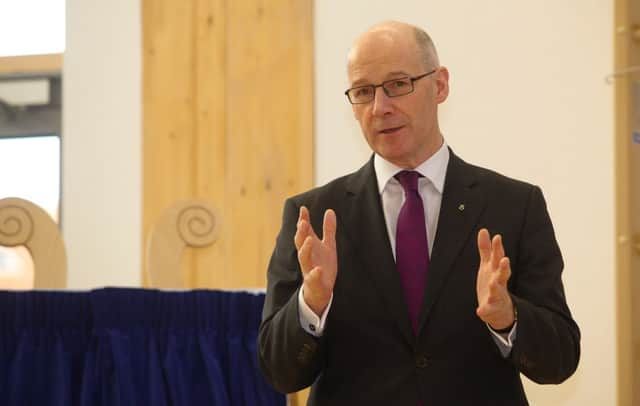John Swinney admits cuts in teacher training places went too far


John Swinney said that with hindsight, the target intake for student teachers was “probably over-corrected too far” in 2011.
In 2005-06, before the SNP came to power, the target number was 4,437, but it then went from 3,857 in 2009-10 to 2,307 in 2010-11 - a drop of 1,550 places.
Advertisement
Hide AdAdvertisement
Hide AdSince then, numbers have risen again to stand at 3,706 in 2016-17.
Mr Swinney said at the time the decision was made to cut the target number, there was a “high level of teacher unemployment”.
He told MSPs on Holyrood’s Education Committee who have been examining teaching workforce levels: “The model obviously was re-calibrated to take into account the fact that teachers couldn’t get employment at that time and our desire was to make sure that teachers could get employment when they had been trained to do so.
“Obviously there has been quite a variation in the intake levels, but they have been affected by the surplus of teachers being able to secure employment.”
Workforce planning for schools considers “a whole range of different factors to arrive at an assumption of how many teachers we need to train to ensure we have an adequate supply of teachers”, he said.
Asked by Labour MSP Daniel Johnson if there had been an over-correction, the Education Secretary conceded: “I think clearly with the benefit of hindsight the intake numbers in 2011 were probably over-corrected too far, but judgments were made at that time based on the level of teacher unemployment.”
Mr Swinney continued by saying if he was to “hazard a guess” as to why there was a problem, he would “suspect we had a greater number of teachers leaving the profession because of some of the issues around workload - which I have now acted to address”.
He added: “I would imagine that factor has exceeded what was expected in the statistical model that we took forward.”
Advertisement
Hide AdAdvertisement
Hide AdBut he insisted Scotland is “not alone as a country in wrestling with availability of teachers”.
Shetland Liberal Democrat MSP Tavish Scott told the Education Secretary the number of teaching vacancies meant “some subjects may not be taught” on the islands in the coming academic year.
Mr Swinney assured him the Scottish Government would “strive and work with our partners to ensure that there is the delivery of the breadth of the curriculum that is expected across the country”.
SNP backbencher Gillian Martin said the committee has heard some councils can wait until a teacher has been off for two weeks before getting a supply teacher in to cover for them.
She said: “We heard certain local authorities were not putting class cover in place, they were expecting teachers would cover classes because they weren’t putting supply teachers in place for a couple of weeks.
“There are workload issues around head teachers having to cover classes because they can’t get supply is an issue.”
Mr Swinney said tackling teacher workload had been one of his priorities since he became Education Secretary, adding: “I have taken a number of steps to try to address that issue.
“There will be two issues here. One will be about the availability of supply cover. If we have a general shortage of members of the teaching profession there may well be challenges in the availability of supply cover in all parts of the country.
Advertisement
Hide AdAdvertisement
Hide Ad“That is again another fact that goes into the workforce planning model, to ensure adequate levels of supply cover available within the system. So there will be genuine issues that have to be confronted there.
“Secondly there will be choices made by local authorities as to how quickly they put supply cover in place, and that is something I would encourage local authorities to be supportive towards schools in delivering that degree of cover as quickly and as promptly as can be put in place, to ensure young people are able to be supported in their education.”
